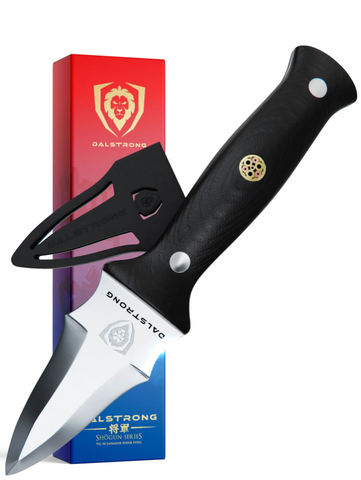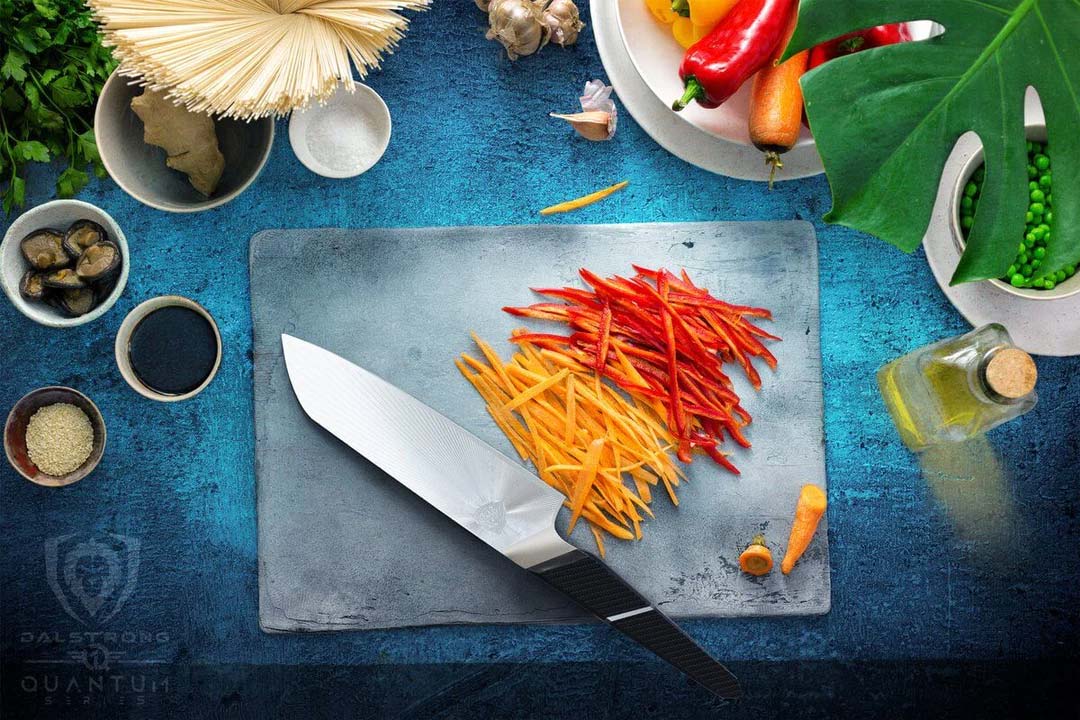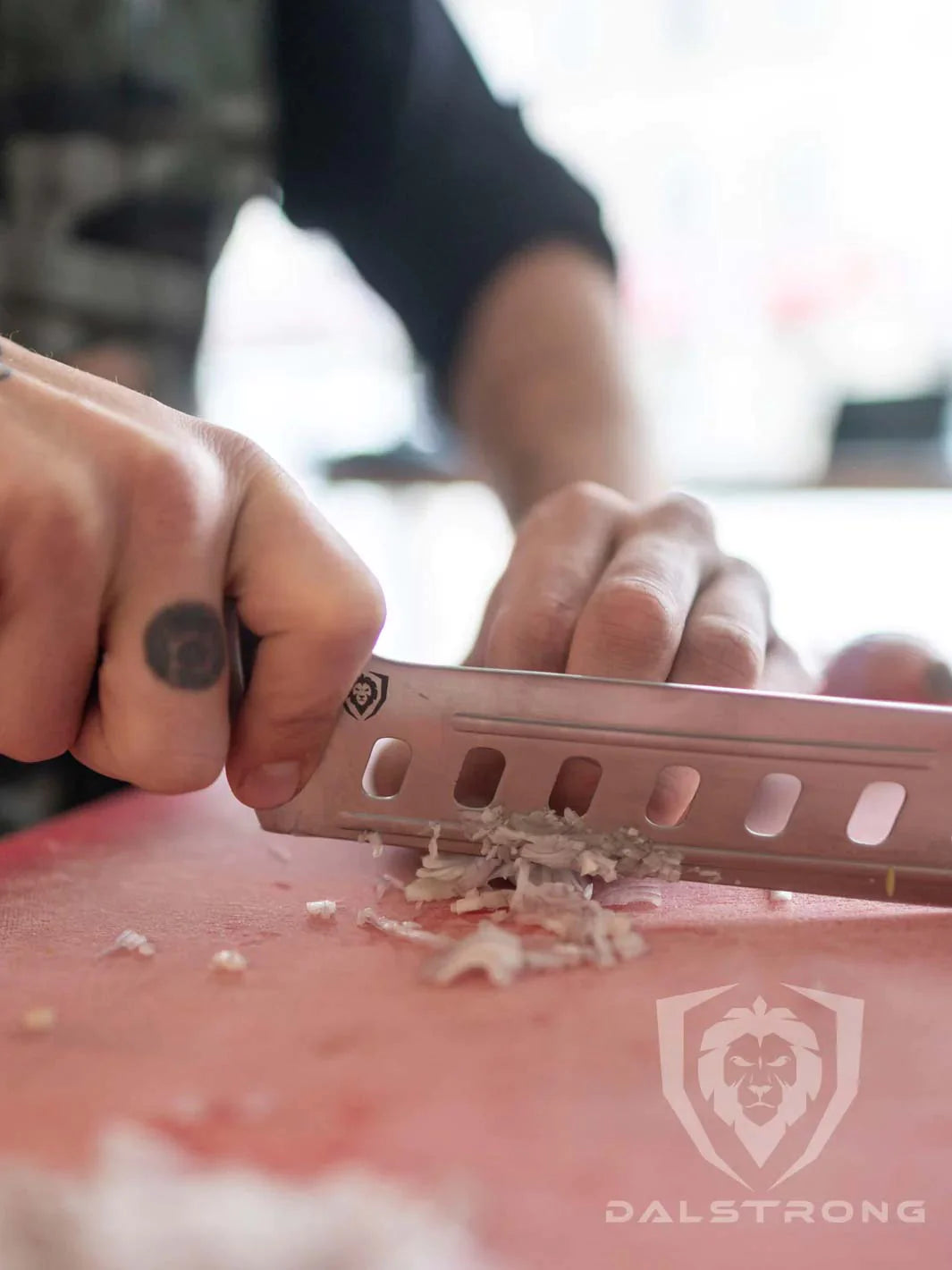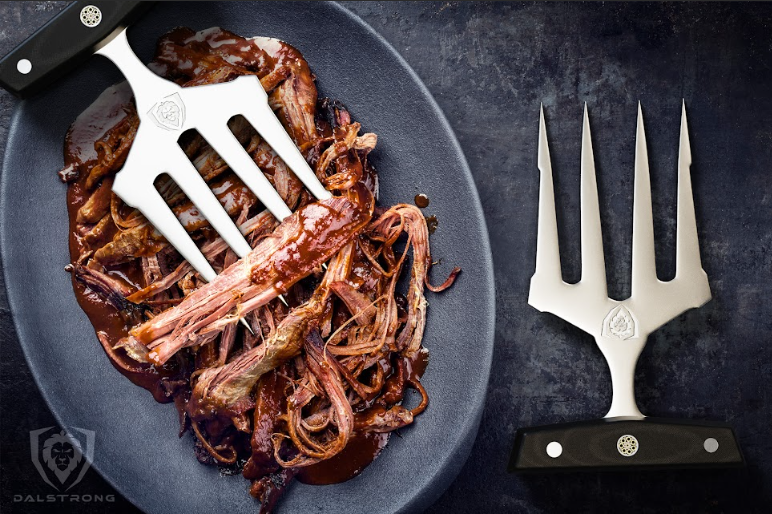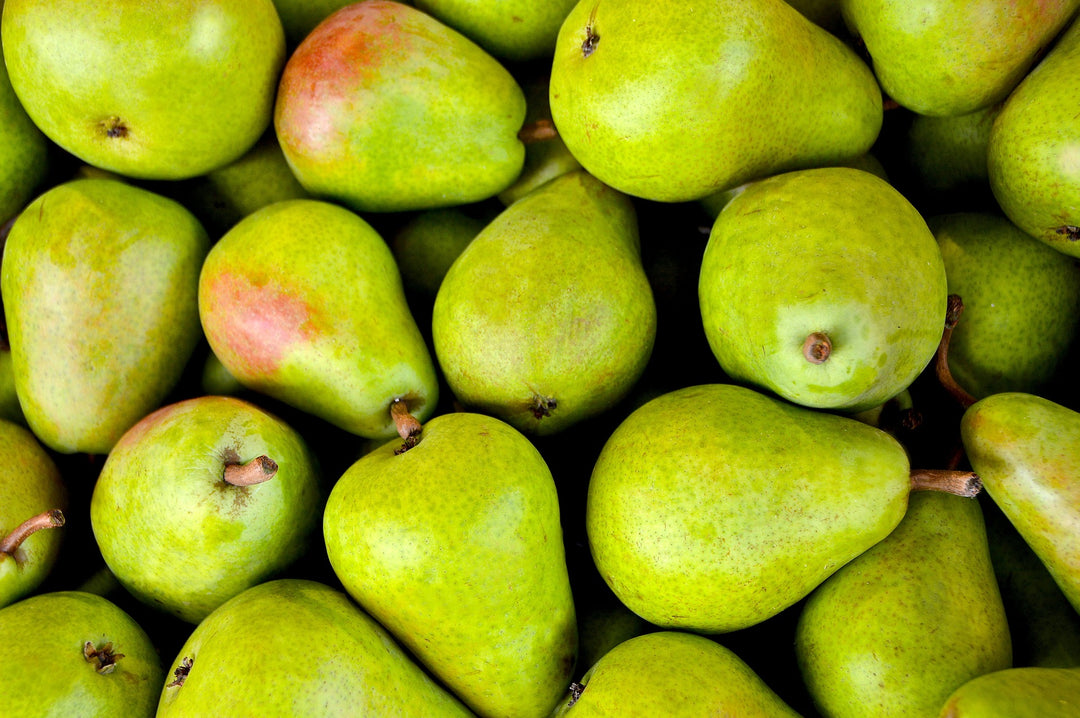Clam Chowder Recipe: A hearty hug in a mug
 Dalstrong Professional Chef's Kitchen Apron - Sous Team 6"
Dalstrong Professional Chef's Kitchen Apron - Sous Team 6"
Quick Steps Overview: Best Clam Chowder Recipe
- Gather all the tools and ingredients
- Combine salt, pork, and water
- Add butter, onion, and celery
- Add clams and turn up the heat
- Remove clams
- Add milk, potatoes, and other ingredients
- Remove meat from clams and chop
- Pour potato mixture through a fine-mesh strainer
- Transfer liquid to a blender
- Add heavy cream
- Season and serve!
Winters make the perfect weather to sit by your window and enjoy a warm cup of flavorful soup. I am a big, big soup eater. But I don’t like those watery, wimpy soup recipes. I absolutely love hearty, full-of-flavor soups that feel like a satisfying meal. And a classic clam chowder has to be one of my favorite comfort foods.
 Shogun Series Professional Oyster & Clam Shucking Knife 3.5"
Shogun Series Professional Oyster & Clam Shucking Knife 3.5"
Chowders are basically creamy, hearty soups with seafood or chicken broth. It all starts with a base of salt pork or bacon and a mix of vegetables like onions, celery, and potatoes. The broth of this clam chowder is creamy with hints of the sea, clams, and potatoes. The beautiful mix of smokey flavors of bacon and the sweetness of onions stir up the perfect storm of flavors in the pot.
Read on to know how to make the perfect creamy Clam Chowder recipe that feels like a big, warm hug in a mug on a cold, windy, winter day.
1. Types of Clams
Let’s get started by understanding the different types of clams available in the market and which one you would need to stir up the perfect chowder:
Hard-shell Clams: Also known as quahogs, are sold by size. The big, large ones are called chowder clams and that is what you want to get for your clam chowder. These clams are tough and good for preparations like chowders and stews, which tenderize them in the cooking process. Medium-sized clams are called cherrystones and the smallest are called littlenecks. You can steam, stuff, bake, grill or even eat these clams raw. The tenderness of the clams decreases with size and littlenecks are the sweetest of them all.
Razor Clams: These are long, narrow clams that look like an old-fashioned straight razor. They taste delicious when steamed.
Manila Clams: These are a type of hard-shelled clams that are found in the Pacific. These can be eaten raw or steamed.
Soft-shell Clams: These are also known as steamers. These clams have a thin, flexible shell and slender, protruding necks. They are eaten steamed only. Soft-shell clams are more perishable than hard-shell clams and often contain sand.
Note: Clams should always be bought alive with hard shells tightly closed. If you are unsure, gently poke the neck and it should retreat slightly.
2. Tips for Buying Fresh Clams
The clams that you would find at your local market or fish market are most alive. Dead clams develop bacteria faster, which is why it is very important to make sure you work with living clams.
Below a couple of things you need to keep in mind when you set out to shop for clams for your chowder:
- Make sure you buy fresh clams that you will find on ice in the seafood case. You will normally find these in breathable bags or loose. If they are in bags, they will have a harvest tag attached to it which will tell you the location, date, and expiry information.If you find clams loose, don’t forget to ask the fishmonger to show you the tag.
- Hard-shell clams are what you need for chowder. Ensure that they are tightly closed. If you feel any of them are open when you get home, gently tap the shell on the counter or flick them with your finger and wait for a few seconds. They will close up if they are alive. If there is no response to the tapping, the clam has died and should be discarded.
- With soft-shell clams, remember that they can’t close all the way. To check if they are alive, tap or touch the side of the shell to see if either move. Again, if there is no response, discard the clam.
- Remember, fresh clams should not smell fishy. Their aroma should be clean and briny, almost like the ocean and salty air.
- If the clams are alive and fresh, do not transfer them to an air-tight container. Fresh clams need to breathe. Restricting the air circulation could smother and spoil them. Remember to keep the top of the bag open even on the ride home from the market.
3. Tools You Will Need
-
Clam Shucking Knife: A strong shucking knife will be required when you will have to pry-open and shuck the clams to get to the meat.
-
Stock Pot: A tall and large pot is a must when cooking any soup. This will ensure that the soup does not overflow in the cooking process.
-
Apron: Shucking clams can get pretty messy, especially if it’s your first attempt. An apron becomes an essential tool in the process.
-
Cutting Board: I cannot emphasize enough the importance of a sturdy cutting board. This is required when chopping lots of vegetables and cutting or slicing meat.
- Fine-Mesh Strainer: You will require a mesh strainer once the potatoes and milk boil so make sure to have one around before you start cooking.
4. How to Shuck Clams?
Shucking clams can be a tricky affair, especially if this is the first time you are working with clams. But when you get used to it and know exactly what needs to be done, you will be able to complete this task in no time.
Before I get into the steps in detail, here are a few things you must keep in mind when shucking clams:
- Always use a proper clam shucking knife so it's easier when you to cut through the shell.
- Open each of the clams over a bowl. Remember to save all that precious juice, aka brine, and not spill it all over the kitchen counter or yourself.
- Shucking is about breaking the adductor muscle which is located on either side of the hinge that binds the clam to its shell.
- Remember, fresh clams can be stubborn so try not to tap them. This will only make the shell tighten up and make it more difficult for you to pry-open.
- If you want to serve the clams on the half-shell, try to keep the clams whole.
- If the upper adductors are severed, make sure to twist off the top shell and gently slide the knife under to loosen the body. This way you will be able to serve the whole clam in the bottom shell with some brine.
Follow these steps to shuck clams like a pro:
- Nestle clam in your palm, with the hinge set in the crook, between your thumb and index finger.
- Insert your shucking knife into the lip on the notched side of the clam and push the knife in with your fingers.
- To open the shell, twist the knife to break the first muscle.
- Open the shell with your fingers and slide the tip of the knife along the top shell to detach the upper muscles.
- Slide the knife on the bottom shell, further loosening the clam from its shell.
- Open the clam with your fingers and detach the clam body entirely.
- Slide clam and brine into a bowl. Grab another clam and start again.
5. Recipe: New England Clam Chowder
The flavor of a creamy clam chowder should be delicate and mild, in which the sweetness of the pork complements the faint bitterness of the clams and is elevated by the bits of celery and onion that have dissolved into the broth. Top this off with a fresh grind of black pepper and voila, you have a mouth watering bowl of soup ready.
You should remember that for the best results, you should use live clams. If live clams are unavailable you can also use 1 pound of chopped canned or frozen clams to the chowder.
|
New England Clam Chowder Recipe |
|||
|
Prep Time 30 mins |
Cook Time 30 mins |
Total Time 1-hour |
Servings 4-6 |
|
Ingredients |
|
|
Live Clams |
|
|
Ingredients |
|
|
Cooking Instructions |
|
|
Step 1: Gather all the tools and ingredients |
|
|
Step 2: Combine salt pork and water |
|
|
Step 3: Add butter, onion, and celery |
|
|
Step 4: Add clams and turn up the heat |
This should take 3 minutes. |
|
Step 5: Remove clams |
|
|
Step 6: Add milk, potatoes, and other ingredients |
|
|
Step 7: Remove meat from clams and chop |
|
|
Step 8: Pour potato mixture through a fine-mesh strainer |
|
|
Step 9: Transfer liquid to a blender |
|
|
Step 10: Add heavy cream |
|
|
Step 11: Season and serve! |
|
6. Alternate Recipe: Manhattan Clam Chowder
|
Manhattan Clam Chowder Recipe |
|||
|
Prep Time 15 mins |
Cook Time 40 mins |
Total Time 55 mins |
Servings 4 |
|
Ingredients |
|
|
Fresh Clam |
|
|
Ingredients |
|
|
Cooking Instructions |
|
|
Step 1: |
|
|
Step 2: |
|
|
Step 3: |
|
|
Step 4: |
|
|
Step 5: |
|
7. Alternate Recipe: Slow Cooker Clam Chowder
|
Slow Cooker Clam Chowder Recipe |
|||
|
Prep Time 30 mins |
Cook Time 7 hours 30 mins |
Total Time 8 hours |
Servings 8 |
|
Ingredients |
|
|
Fresh Clam |
|
|
Ingredients |
|
|
Cooking Instructions |
|
|
Step 1: |
|
|
Step 2: |
|
|
Step 3: |
|
|
Step 4: |
|
|
Step 5: |
|
|
Step 6: |
|
8. Nutrition Facts
|
New England Clam Chowder Recipe |
|
|
Calories |
767kcal |
|
Total Fat |
56g |
|
Saturated Fat |
26g |
|
Carbohydrates |
42g |
|
Protein |
24g |
|
Cholesterol |
137mg |
|
Sodium |
2077mg |
|
Potassium |
1364mg |
|
Vitamin C |
25mg |
|
Calcium |
301mg |
|
Iron |
3mg |
9. Serving Suggestions
It is very easy to identify when the clams are done. Once they open up, it means your clams are ready to be served. So whether you are steaming, grilling or baking clams, it is easy to know when they are ready to eat.
You must plan 1-2 dozens of clams per person for your party. This is normally a pretty good benchmark for estimating how many clams you are going to need to buy. Typically, a 3-ounce serving will have about 12 medium-sized cooked clams.
Now that you now know how to make a hearty clam chowder, here’s a list of some sides that pair very well with it:
- Fluffy dinner rolls
- Crispy oyster crackers
- Fresh salad
- Roasted vegetables
- Corn on cob
- French fries
- Crispy bacon strips
- Cornmeal pancakes
- Mussels
- Calamari
- Salmon
10. How to Store Clam Chowder?
Clam chowder leftovers are my favorite! In fact, I feel like clam chowders taste better the next day.
If you have any clam chowder leftovers, wait for it to cool down and then place it in an airtight container. Place the container in your refrigerator. Your clam chowder leftovers should last 3-4 days if stored properly.
11. Shucking Knife Recommendation
No matter if you are an experienced chef or a new cook shucking for the first time, it is very important to shuck confidently and safely. There maybe plenty of optionsin the market, when it comes to adding a shucking knife to my kitchen arsenal, this is the knife I would invest in and recommend you to do the same:
1) Professional Clam Shucking Knife 3.5”- Dalstrong
This shucking knife is designed to make tasks like shucking clams and oyster a breeze. The rock-solid blade of this knife allows you to easily pry-open and shuck the toughest of shellfish and ensure removing the soft, juicy meat without tearing the delicate flesh.
The blade of this knife has a pointed tip for sliding between tight shells while the long and sturdy handle provides great leverage to pop the shellfish open. This stylish yet strong knife is well-suited for restraunts, bars, dinner parties and a great option to add to your kitchen knife set.
Pros:
- The blade of the knife is highly impervious to heat, cold and moisture, ensuring that the blade lasts you a lifetime, making this a one-time investment.
- The handle of this knife is designed to provide you with maximum wrist support and comfort while assisting you tirelessly.
- The scalpe-like sharpness of the blade ensures excellent edge retention, ensuring that the blade does not dull quickly.
Cons:
- A shucking knife is a great addition to your kitchen knife set but it can be tricky to use. You will have to practice, probably even watch a few videos before you get a hang of how to make it work effortlessly.
- For someone new to cooking clams, the price of this knife might not be ideal. In that case, you can also find a paring knife that’s in budget and can be used to practice shucking before investing in the shucking knife.
12. Frequently Asked Questions
What three ingredients must a chowder have to be considered a chowder?
Chowders are rish, hearty soup recipes. The 3 main ingredients are seafood like clams, salt pork, and potatoes. Other ingredients that add flavor to the chowder are celery, onions, salt, and freshly ground black pepper.
How many types of clam chowders are there?
While there are roughly about 8 types of clam chowders in total, the most common types include New England Clam Chowder, Manhattan Clam Chowder and Rhode Island Clam Chowder.
Do you drain canned clams?
If you are using canned clams, drain them, reserving the liquid. Add enough water to the reserved clam juice to make 1½ cups.
How do you make New England clam chowder better?
The best way to amp up the flavor of your clam chowder is by adding the brine of the clams to the soup. This is why it is very important to save the brine or juice that falls out of the clams while shucking it.
















































































































































